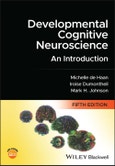Landmark text focusing on the development of brain and behavior during infancy, childhood, and adolescence
Developmental Cognitive Neuroscience provides an accessible introduction to the main methods, theories, and empirical findings of developmental cognitive neuroscience. The focus is on human development from in utero to early adulthood, but key comparative work is also included. This new edition covers research in clinical/medical populations, educational applications and major advancements in methods and analysis, in particular with increasing longitudinal research focusing on understanding the mechanisms of cognitive development. It also contains a new chapter on global and cross-cultural perspectives outlining how developmental cognitive neuroscience has been applied in different settings and how techniques can be successfully adapted.
The text features a variety of student-friendly features such as chapter-end discussion, applications of basic research, and introductions to key experimental methods. An accompanying related resource website for students and educators that includes a test bank of multiple choice questions is also provided.
Other sample topics covered in Developmental Cognitive Neuroscience include:
- Biology of change, methods, and populations, from gene to brain, building a brain, and vision, orienting, and attention
- Perceiving and acting in a world of objects, learning, and long-term memory, language, and prefrontal cortex, working memory, and decision-making
- Perceiving and acting in the social world, educational neuroscience, interactive specialization, and integrating development cognitive neuroscience
- Mid-childhood and adolescent development, social cognition and neuroimaging, and broader cognitive neuroscience approaches and theory
Table of Contents
List of Figures x
List of Tables xvii
List of Abbreviations xviii
Preface to the First Edition xx
Preface to the Fifth Edition xxii
About the Companion Website xxiii
1 The Biology of Change 1
Viewpoints on Development 1
Analyzing Development 5
Why Take a Cognitive Neuroscience Approach to Development? 6
Why Take a Developmental Approach to Cognitive Neuroscience? 7
The Cause of Developmental Change 8
Three Viewpoints on Human Functional Brain Development 10
Interactive Specialization 11
Looking Forward 12
2 Methods and Populations 14
Introduction 14
Behavioral and Cognitive Tasks 15
Assessing Brain Function in Development 16
Observing Brain Structure in Development 18
Animal Studies and Genetics 19
Neurodiversity and Developmental Disorders 20
Atypically Developing Brains 22
Sensory and Environmental Variations 25
Familial Risk Populations 26
3 From Gene to Brain 28
The History of the Gene 28
Principles of Gene Function 29
Genetics and Developmental Cognitive Neuroscience 32
The Epigenome 36
The FOXP2 Gene 36
4 Building a Brain 39
An Overview of Primate Brain Anatomy 40
Prenatal Brain Development 43
Postnatal Brain Development 46
The Development of Cortical Areas: Protomap or Protocortex? 53
Differential Development of Human Cortex 61
Postnatal Brain Development: Adolescence 64
Postnatal Brain Development: The Hippocampus and Subcortical Structures 65
Neurotransmitters and Neuromodulators 66
What Makes a Brain Human? 69
General Summary and Conclusions 70
5 Vision, Orienting, and Attention 71
The Development of Vision 71
The Development of Visual Orienting 76
Saccade Planning 86
Visual Attention 89
General Summary and Conclusions 95
6 Perceiving and Acting in a World of Objects 97
The Dorsal and Ventral Visual Pathways 98
Hidden Objects 101
Neural Oscillations and Object Processing 105
General Summary and Conclusions 106
7 Perceiving and Acting on the Social World 107
The Social Brain 107
Face Recognition 109
Brain Development and Face Recognition in Humans 113
Perceiving and Acting on the Eyes 120
Understanding and Predicting the Behavior of Others 123
The Atypical Social Brain 127
General Summary and Conclusions 131
8 Learning and Long- Term Memory 133
Development of Explicit Memory 135
Implicit Memory 143
General Summary and Conclusions 145
9 Language 147
Introduction 147
Are Some Parts of Cortex Critical for Language Acquisition? 149
Neural Basis of Speech Processing in Infants 155
Influence of Experience on Brain Language Processing 156
Neural Correlates of Typical and Atypical Language Acquisition 158
General Summary and Conclusions 161
0005539305.indd 8 03-16-2023 10:44:52
10 Prefrontal Cortex, Executive Functions, and Decision- Making 163
Introduction 164
Prefrontal Cortex and Object Permanence 164
Prefrontal Cortex and Executive Functions Development During Adolescence 166
Social Decision- Making and Self- Regulation During Adolescence 170
Prefrontal Cortex, Skill Learning, and Interactive Specialization 173
General Summary and Conclusions 177
11 Educational Neuroscience 179
Numeracy 181
Literacy 185
Domain- General Skills: Executive Functions and Processing Speed 186
Individual Differences and Training Interventions 189
Dyscalculia and Dyslexia 192
General Summary and Conclusions 195
12 Global and Cross- Cultural Perspectives 197
Developmental Cognitive Neuroscience: Factors to Consider in Global, Cross- Cultural Settings 198
Cognitive Neurosciences Approaches to Look at Commonalities Across Global/Cultural Settings 199
Infants’ Response to Novelty 199
Social Processing 200
Numeracy and Literacy 202
Developmental Cognitive Neuroscience: Examining Factors Affecting Similarities and Differences Among Global Settings and Cultures 203
Maternal Stress, Caregiving and Education and Brain Responses to Social Stimuli 203
Interactions Between Factors Predicting Individual Differences in Neurocognition 203
Brain Responses in the Context of Global- Specific Risk 204
General Summary and Conclusions 204
13 Toward an Integrated Developmental Cognitive Neuroscience 206
Introduction 206
Three Viewpoints on Human Functional Brain Development 207
Interactive Specialization (IS) 209
Emerging Networks 213
Genes and Cognitive Development 217
Relations Between Brain Structure and Function in Development 218
Neuroconstructivism 219
Criticisms of Developmental Cognitive Neuroscience 221
Applications of Developmental Cognitive Neuroscience 223
Concluding Remarks 224
References 225
Index 282








